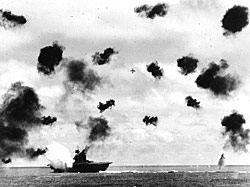
Unit 5: Crisis and Change
Lesson F: The Failure of Democracy and Return of War
Lesson Overview


USS Yorktown is Hit on the Port Side by a Japanese Torpedo During the Battle of Midway, June 4, 1942.[1]
Expanding militaries, alliances, imperialism, and nationalism in Europe and Asia changed the world during the 1930s. There was a pattern of aggression from Germany, Italy, and Japan. Responses to the aggression by major countries were ineffective, and the League of Nations seemed almost powerless when dealing with foreign policy crises. When Adolf Hitler, the leader of Germany, became increasingly more aggressive in the late 1930s, other leaders tried a policy of appeasement. The efforts did not work, and the eventual result was World War II, which began in Europe in 1939. The early years of World War II were difficult for the Allies, but, when the U.S. and the U.S.S.R. joined the war, there were gains against the Axis Powers. World War II continued the trend of total war from World War I. This conflict was the most extensive war ever to be fought on all of the major seas and on the continents of Africa, Asia, and Europe. This lesson focuses on the early years of the war (1939-1943). The conclusion of the war and its aftermath are the focus of the next lesson.
Key Questions
- Why do countries go to war?
- Should governments protect national security and economic well-being at the expense of civil liberties?
- Why did the conflicts and crises of the first half of the 20th century become global in nature?
- How did the conflicts and crises of the first half of the 20th century impact the world?
Student Outcomes
- Explain the ideologies of fascism and Nazism and analyze how fascist and authoritarian regimes seized power and gained mass support in Italy, Germany, Spain, and Japan.
- Compare and contrast the totalitarian regimes that emerged in Italy, Germany, Spain, and Japan with that of Stalin's Soviet Union.
- Analyze how the legacy of World War I, the Depression, ideological conflicts, imperialism, and traditional rivalries were underlying causes of World War II.
- Examine how the quest for empire of Germany, Italy, and Japan led to early conflict in nations such as Poland, Ethiopia, and China (Manchuria).
- Analyze how the policies of appeasement and nonaggression by nations such as Great Britain, France, the United States, and the Soviet Union and the failure of the League of Nations led to the continued aggression of Germany, Italy, and Japan.
- Compare World War I and World War II in terms of the impact of industrial productions, political goods, national mobilization, technological innovations, and scientific research on strategies, tactics, and levels of destruction.
- Interrogate historical data. (Historical Thinking Skill)
- Support interpretations with historical evidence. (Historical Thinking Skill)
Key Terms
- aggression
- Anschluss
- anti-Semitism
- appeasement
- armistice
- authoritarian
- blitzkrieg
- expansionism
- fascism
- genocide
- imperialism
- interpretation
- League of Nations
- lebensraum
- Nazism
- nonaggression
- reparations
- totalitarian
Student Resources
- M.A.I.N. and the Causes of World War II
- Authoritarian and Totalitarian Regimes Graphic Organizer
- Historical Interpretations - Causes of World War II Directions (pdf)
- Background Reading - Treaty of Versailles and League of Nations (pdf)
- World War II Timeline Graphic Organizer (doc)
- Timeline for World War II - France (pdf)
- Timeline for World War II - Germany (pdf)
- Timeline for World War II - Great Britain (pdf)
- Timeline for World War II - Italy (pdf)
- Timeline for World War II - Japan (pdf)
- Timeline for World War II - Spain (pdf)
- Timeline for World War II - United States (pdf)
- Timeline for World War II - U.S.S.R. (pdf)
- Historical Interpretation - Set A Documents (doc)
- Historical Interpretation - Set B Documents (doc)
- Historical Interpretation - Set C Documents (doc)
- Historical Interpretation - Set D Documents (doc)
- Historical Interpretation - Set E Documents (doc)
- Historical Interpretation - Set F Documents (doc)
- Writing the Historical Interpretation (doc)
Chart of Activities
| Activities to Complete | Estimated Time |
|---|---|
| Pre-Assessment | 5 minutes |
| Key Terms | 15 minutes |
| Activator: The World - 1939 - 1943 | 10 minutes |
| Opening: M.A.I.N. and the Causes of WWII | 20 minutes |
| Activity 1: Short and Long Term Causes of WWII | 30 minutes |
| Activity 2: M.A.I.N. Review | 15 minutes |
| Activity 3: Authoritarian and Totalitarian Regimes | 30 minutes |
| Activity 4: The Beliefs and Actions of Nations | 10 minutes |
| Activity 5: Historical Interpretation | 20 minutes |
| Activity 6: Quest for Empire | 20 minutes |
| Activity 7: Causes of World War II | 20 minutes |
| Review and Assessment | 20 minutes |
| Lesson Summary | 5 minutes |
Lesson Completion Time
The total estimated time to complete this lesson is 220 minutes.
Page Notes:
[1] Source: This image from http://en.wikipedia.org/wiki/File:USS_Yorktown_hit-740px.jpg is a work of the United States government and therefore in the public domain.

